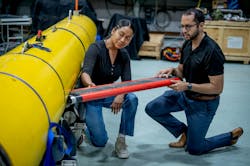Navy asks General Dynamics to upgrade uncrewed underwater vehicles for newly developed sensor payloads
Summary points:
- The U.S. Naval Research Laboratory is asking General Dynamics Mission Systems to upgrade and support Black Pearl-class autonomous underwater vehicles under terms of a $21.5 million contract.
- Upgrades will enable the Black Pearl to support new NRL-developed sensor and mission payloads for advanced undersea warfare research.
- General Dynamics is original designer of the Black Pearl, which is based on the Bluefin 21 UUV.
WASHINGTON – U.S. Navy undersea researchers needed to upgrade existing uncrewed underwater vehicles (UUVs) to accommodate new sensor and mission payloads. They found a solution from General Dynamics Mission Systems in Quincy, Mass.
Officials of the The Naval Research Laboratory (NRL) in Washington announced plans on Tuesday to award a $21.5 million contract to General Dynamics Mission Systems to design and test Black Pearl-class autonomous underwater vehicles (AUVs).
General Dynamics will design and modify NRL's existing Black Pearl UUVs to accommodate newly developed NRL payloads. General Dynamics will build and deliver five modified Black Pearl UUVs to accommodate NRL payloads, as well as provide vehicle maintenance, at-sea operations support, and engineering support for Black Pearl UUVs during research missions.
NRL uses Black Pearl for undersea warfare research, often upgrading and modifying the vehicles to accommodate new research sensor payloads and meet new mission requirements.
General Dynamics won the contract sole-source because the company is the original designer of the Black Pearl UUV, and no one else could do the job as quickly and affordably.
Black Pearl is a 21-inch-diameter UUV designed for research and military applications by the Navy and Bluefin Robotics for mine countermeasures, anti-submarine warfare (ASW), and distributed sensing research. General Dynamics acquired Bluefin Robotics in 2016. Black Pearl is based on the Bluefin 21 UUV.
Black Pearl is 16.2 feet long and weighs 1,650 pounds. It moves through the water as fast as five nautical miles per hour, can dive as deeply as 1,300 feet, and can operate for more than 24 hours on one battery charge.
Inertial navigation
Black Pearl navigates by GPS-aided inertial navigation system with a Doppler velocity log using a fiber-optic gyro. It can communicate at over-the-horizon distances with Iridium satellite communications while surfaced for status updates and redirection.
Black Pearl has modular payload bays for rapid reconfiguration between missions, and has sensors and signal processing that include broadband low-frequency sonars for mine countermeasures and anti-submarine warfare (ASW); environmental sensors to measure water depth, temperature, current, and the speed of sound through the water; ; acoustic modem research payloads; and side-scan and multi-beam sonar.
For more information contact General Dynamics Mission Systems online at https://gdmissionsystems.com/underwater-vehicles/bluefin-robotics, or the Naval Research Laboratory at www.nrl.navy.mil.
About the Author
John Keller
Editor-in-Chief
John Keller is the Editor-in-Chief, Military & Aerospace Electronics Magazine--provides extensive coverage and analysis of enabling electronics and optoelectronic technologies in military, space and commercial aviation applications. John has been a member of the Military & Aerospace Electronics staff since 1989 and chief editor since 1995.
